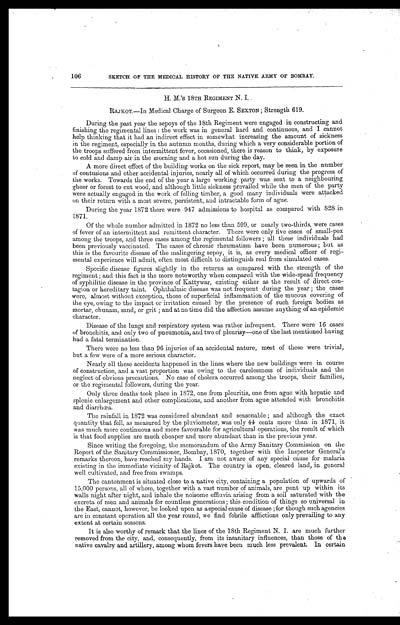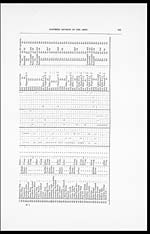Medicine - Institutions > Army health reports and medical documents > Sketch of the medical history of the native army of Bombay > Sketch of the medical history of the native army of Bombay, for the year 1872
(109) Page 106
Download files
Individual page:
Thumbnail gallery: Grid view | List view

106
SKETCH OF THE MEDICAL HISTORY OF THE NATIVE ARMY OF BOMBAY.
H. M.'s 18TH REGIMENT N. I.
RAJKOT.—In Medical Charge of Surgeon E. SEXTON; Strength 619.
During the past year the sepoys of the 18th Regiment were engaged in constructing and
finishing the regimental lines: the work was in general hard and continuous, and I cannot
help thinking that it had an indirect effect in somewhat increasing the amount of sickness
in the regiment, especially in the autumn months, during which a very considerable portion of
the troops suffered from intermittent fever, occasioned, there is reason to think, by exposure
to cold and damp air in the morning and a hot sun during the day.
A more direct effect of the building works on the sick report, may be seen in the number
of contusions and other accidental injuries, nearly all of which occurred during the progress of
the works. Towards the end of the year a large working party was sent to a neighbouring
gheer or forest to cut wood, and although little sickness prevailed while the men of the party
were actually engaged in the work of felling timber, a good many individuals were attacked
on their return with a most severe, persistent, and intractable form of ague.
During the year 1872 there were 947 admissions to hospital as compared with 828 in
1871.
Of the whole number admitted in 1872 no less than 599, or nearly two-thirds, were cases
of fever of an intermittent and remittent character. There were only five cases of small-pox
among the troops, and three cases among the regimental followers; all these individuals had
been previously vaccinated. The cases of chronic rheumatism have been numerous; but as
this is the favourite disease of the malingering sepoy, it is, as every medical officer of regi-
mental experience will admit, often most difficult to distinguish real from simulated cases.
Specific disease figures slightly in the returns as compared with the strength of the
regiment; and this fact is the more noteworthy when compared with the wide-spead frequency
of syphilitic disease in the province of Kattywar, existing either as the result of direct con-
tagion or hereditary taint. Ophthalmic disease was not frequent during the year; the cases
were, almost without exception, those of superficial inflammation of the mucous covering of
the eye, owing to the impact or irritation caused by the presence of such foreign bodies as
mortar, chunam, sand, or grit; and at no time did the affection assume anything of an epidemic
character.
Disease of the lungs and respiratory system was rather infrequent. There were 16 cases
of bronchitis, and only two of pneumonia, and two of pleurisy—one of the last mentioned having
had a fatal termination.
There were no less than 96 injuries of an accidental nature, most of these were trivial,
but a few were of a more serious character.
Nearly all these accidents happened in the lines where the new buildings were in course
of construction, and a vast proportion was owing to the carelessness of individuals and the
neglect of obvious precautions. No case of cholera occurred among the troops, their families,
or the regimental followers, during the year.
Only three deaths took place in 1872, one from pleuritis, one from ague with hepatic and
splenic enlargement and other complications, and another from ague attended with bronchitis
and diarrhœa.
The rainfall in 1872 was considered abundant and seasonable; and although the exact
quantity that fell, as measured by the pluviometer, was only 44 cents more than in 1871, it
was much more continuous and more favourable for agricultural operations, the result of which
is that food supplies are much cheaper and more abundant than in the previous year.
Since writing the foregoing, the memorandum of the Army Sanitary Commission on the
Report of the Sanitary Commissioner, Bombay, 1870, together with the Inspector General's
remarks thereon, have reached my hands. I am not aware of any special cause for malaria
existing in the immediate vicinity of Rajkot. The country is open, cleared land, in general
well cultivated, and free from swamps.
The cantonment is situated close to a native city, containing a population of upwards of
15,000 persons, all of whom, together with a vast number of animals, are pent up within its
walls night after night, and inhale the noisome effluvia arising from a soil saturated with the
excreta of men and animals for countless generations; this condition of things so universal in
the East, cannot, however, be looked upon as a special cause of disease; for though such agencies
are in constant operation all the year round, we find febrile afflictions only prevailing to any
extent at certain seasons.
It is also worthy of remark that the lines of the 18th Regiment N. I. are much further
removed from the city, and, consequently, from its insanitary influences, than those of the
native cavalry and artillery, among whom fevers have been much less prevalent. In certain
Set display mode to: Large image | Zoom image | Transcription
Images and transcriptions on this page, including medium image downloads, may be used under the Creative Commons Attribution 4.0 International Licence unless otherwise stated. ![]()
| Permanent URL | https://digital.nls.uk/75012965 |
|---|




